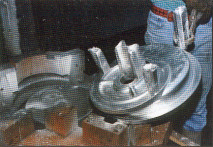|
|
 |
|||||||||
|
|
Information for Schools Although aluminium is the third most abundant element, after oxygen and silicon, it has not been used for as long as gold or copper, which are much rarer. Although there is almost double the amount of aluminium in the planet's crust than there is of iron aluminium was discovered only some 160 years ago and has been produced in industrial quantities for only the last 100 years. This is because aluminium is never found in its natural form as a pure metal. Instead, it always forms very stable chemical compounds (e.g., alumino-silicates) locked in, or mixed with, other elements which occurring in most rocks, vegetation and soils, in fact, in nearly everything. Now, however, more aluminium is produced each year than any other non-ferrous metal. It was in 1807, that Sir Humphrey Davy, the British scientist, established the existence of the element aluminium which he called "Aluminum", the spelling still used in the USA. The world had to wait over 80 years for aluminium, with its attractive properties, to become easily and cheaply available for industrial purposes. In 1886, Charles Martin Hall, in the USA, Paul L T Heroult, in France, independently perfected the electrolytic method for producing aluminium from aluminium oxide (alumina). The German Karl Bayer built upon their success in 1888 by developing a cheap production method for alumina from bauxite ore. The price of aluminium plunged from $18 to $4.50 per kg. World production of refined aluminium has grown to a present-day level exceeding 18,000,000 metric tonnes anually. Aluminium and its alloys possess a diverse range of physical, chemical, and mechanical properties. Aluminium has a very low density - it is only one-third the weight of steel. When used in the transport industry this means that vehicles can be more fuel-efficient. Aluminium and most of its alloys are highly resistant to most forms of corrosion because the metal's natural coating of aluminium oxide provides a highly effective barrier to the elements and to chemical attack (within the pH range of about 4 to 8). It is a highly efficient conductor of electricity making it an ideal replacement for copper for many applications. Non-magnetic and non-combustible, it is ideal for many electronics applications. Aluminium is non-toxic and impervious to water - guranteeing its widespread use in the food and packaging industries. Other valuable properties include its high reflectivity, heat conductivity and its heat barrier properties. The thermal conductivity of aluminium is about four times that of steel and its specific heat twice that of steel. This means that heat is conducted away faster and more heat is required to raise the temperature of a mass of aluminium compared to an identical mass of steel. This makes aluminium an ideal material for uses such as motorcycle cooling fins and fire resistance. It is malleable and easily worked by traditional manufacturing and shaping processes. And at Skaigh in particular... In general, all commercial casting alloys are made from recycled material, and as at the moment all our castings are commercial, you can say that all our material is recycled. As far as the wrought alloys are concerned, I don't think this is appropriate for us. We currently work to BS1490:1988, but in time this will be superseded by EN1676:1996 , details of which should be available, although nobody I know uses it yet. Our ingot suppliers are secondary smelters who are mostly located in the Midlands. Our method of production is gravity or permanent mould diecasting and the alloys we commonly use are LM4, LM6 and LM25 but we also use LM5 andLM9. Although it is impossible to eliminate corrosion entirely, various steps can be taken to minimise the problem. Firstly, it may be possible to eliminate any potential problem areas at the design stage and in the design of the tooling. Secondly, corrosion caused by high impurity levels in the alloy can be overcome by using relatively high quality material i.e. closely controlled alloying and impurity levels and only using certificated material. Some foundries only use ingot, and return their arisings for remelting at a refiners. We have never gone that far, but we have on occasion used ingot only on specified jobs. Finally, it is possible to treat castings by anodising or painting, both of which we sub-contract out. Welding is accepted by many customers, but we do not do any here. Aluminium welding is still a fairly specialised business. |
|
||||||||
|
Tel: +44 (0)1626 852159 - Fax: +44 (0)1626 853495 |
||||||||||





